The Haswell Review: Intel Core i7-4770K & i5-4670K Tested
by Anand Lal Shimpi on June 1, 2013 10:00 AM ESTCPU Performance: Five Generations of Intel CPUs Compared
For the purposes of our look at Haswell, we will be breaking up our review coverage into two parts. The rest of this article will focus on the CPU side of Haswell, while coverage of the GPU - including Iris Pro and Crystalwell - has been spun off into another artice: Intel Iris Pro 5200 Graphics Review: Core i7-4950HQ Tested.
The majority of the market doesn’t upgrade annually, so I went back a total of five generations to characterize Haswell’s CPU performance. Everything from a 2.53GHz Core 2 Duo through Nehalem, Sandy Bridge, Ivy Bridge and Haswell are represented here. With the exception of the Core 2 platform, everything else is running at or near the peak launch frequency for the chip.
In general, I saw performance gains over Ivy Bridge of 1 - 19%, with an average improvement of 8.3%. Some of the performance gains were actually quite impressive. The 7.8% increase in Kraken shows there’s still room for improvement in lightly threaded performance, while the double digit FP performance gains in POV-Ray and x264 HD really play to Haswell’s strengths.
Compared to Sandy Bridge, Haswell looks even more impressive. The Core i7-4770K outperforms the i7-2700K by 7 - 26%, with an average performance advantage of 17%. The gains over Sandy Bridge aren’t large enough to make upgrading from a Sandy Bridge i7 to a Haswell i5 worthwhile though, as you still give up a lot if you go from 8 to 4 threads on a quad-core part running heavily threaded workloads.
Compared to Nehalem the gains average almost 44%.
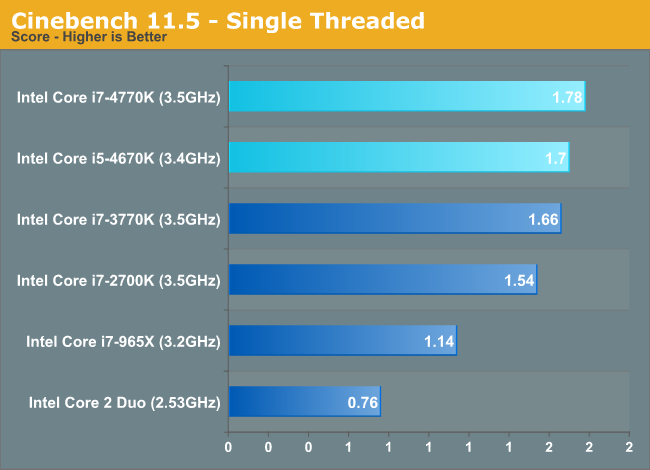


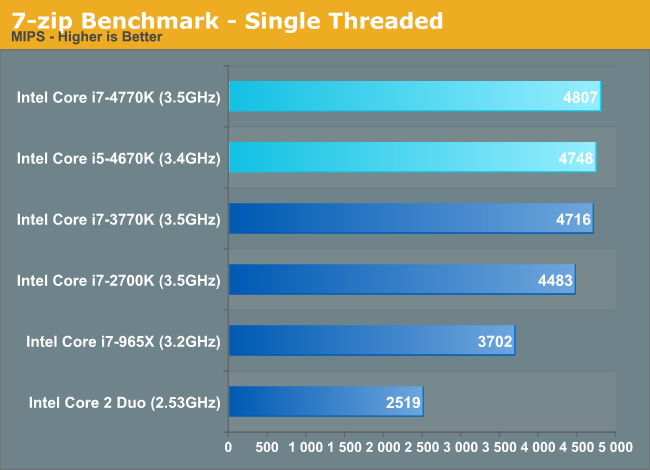
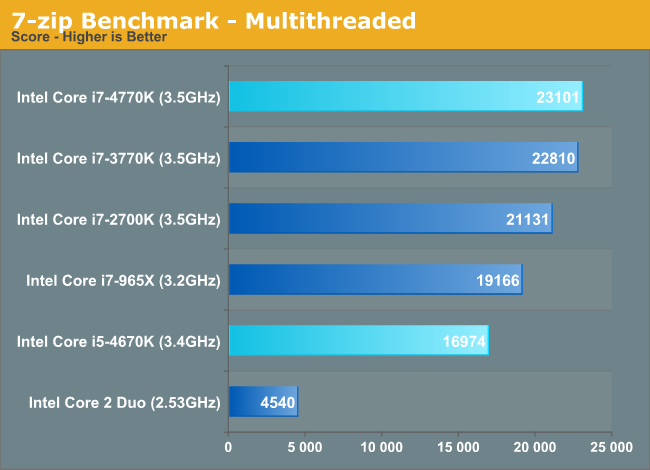
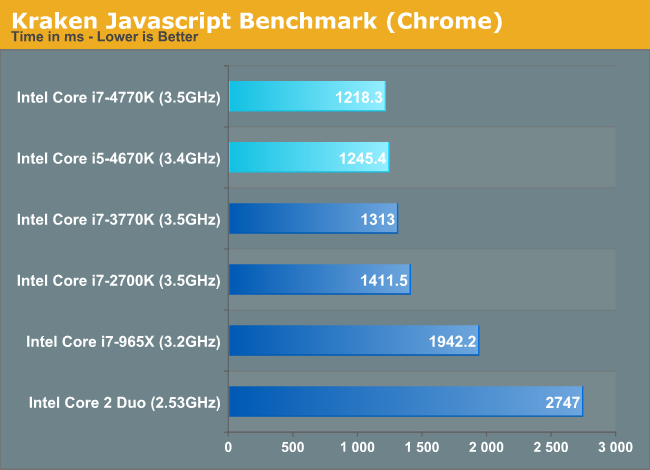
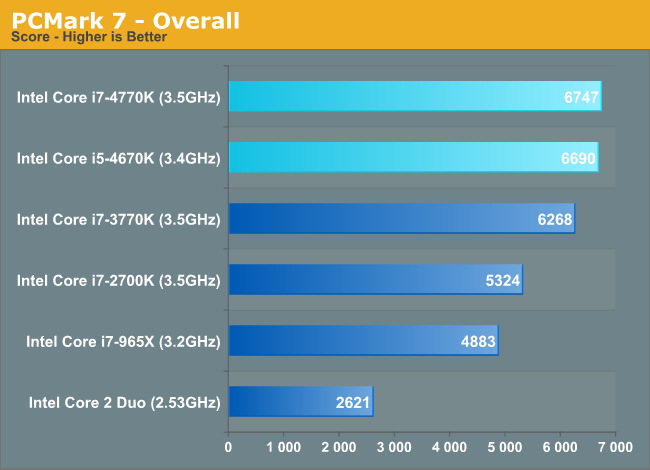
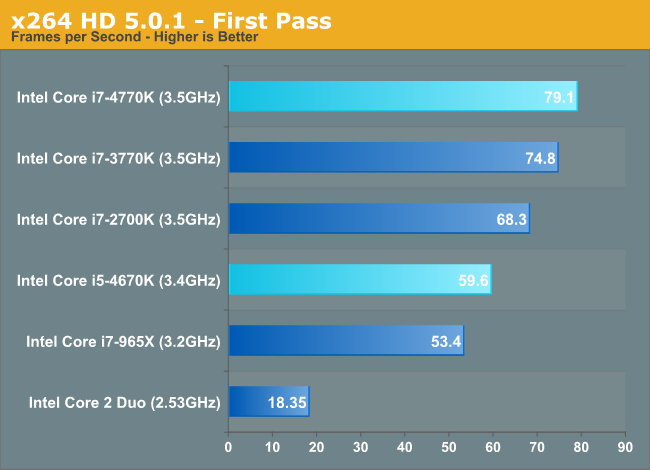
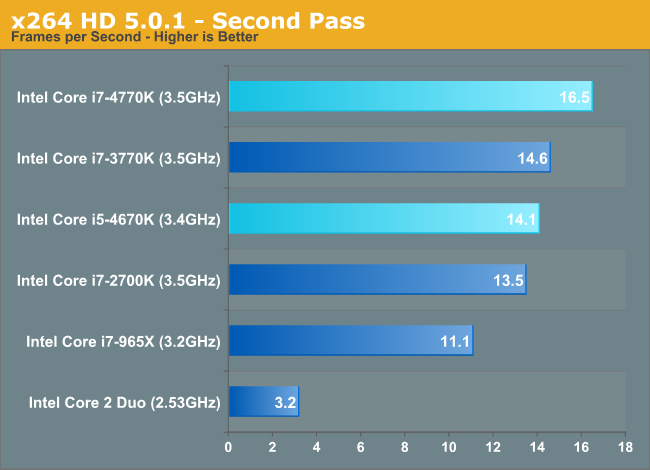
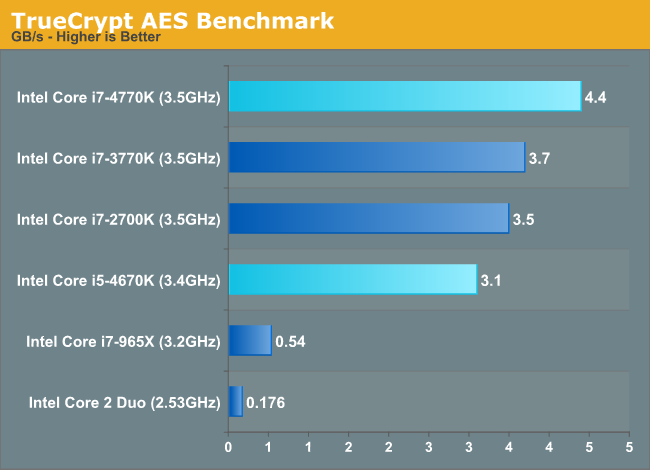

Quite possibly the most surprising was just how consistent (and large) the performance improvements were in our Visual Studio 2012 compile test. With a 15% increase in performance vs. Ivy Bridge at the same frequencies, what we’re looking at here is the perfect example of Haswell’s IPC increases manifesting in a real-world benchmark.
Gaming Performance
After spending far too much time on the Iris Pro test system, I didn’t have a ton of time left over to do a lot of gaming performance testing with Haswell. Luckily Ian had his gaming performance test data already in the engine, so I borrowed a couple of graphs.
As expected, Haswell is incrementally quicker in GPU bound gaming scenarios compared to Ivy Bridge - and most definitely at the top of the charts.
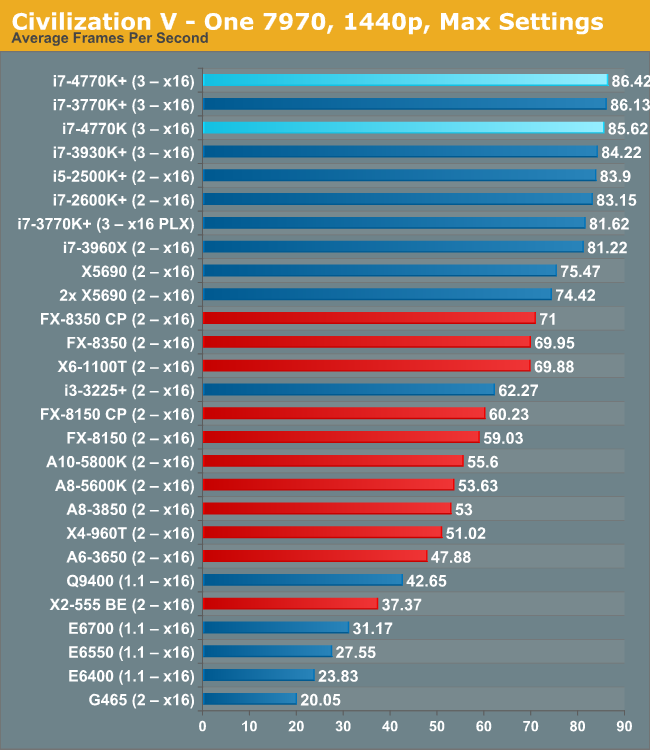











210 Comments
View All Comments
chizow - Saturday, June 1, 2013 - link
The other big problem with the CPU space besides the problems with power consumption and frequency, is the fact Intel has stopped using it's extra transistor budget from a new process node on the actual CPU portion of the die long ago. Most of the increased transistor budget afforded by a new process goes right to the GPU. We will probably not see a stop to this for some time until Intel reaches discrete performance equivalency.Jaybus - Monday, June 3, 2013 - link
Well, I don't know. Cache sizes have increased dramatically.chizow - Monday, June 3, 2013 - link
Not per core, these parts are still 4C 8MB, same as my Nehalem-based i7. Some of the SB-E boards have more cache per core, 4C 10MB on the 3820, 6C 15MB on the 3960/3970, but the extra bit results in a negligible difference over the 2MB per core on the 3930K.Boissez - Sunday, June 2, 2013 - link
I think you've misunderstood me.I'm merely pointing out that, in the past 2½ years we've barely seen any performance improvements in the 250-300$ market from Intel. And that is in stark contrast to the developments in mobileland. They too, are bound by the constraints you mention.
And please, stop the pompous know-it-all attitude. For the record, power consumption actually rises *linearly* with clock speed and *quadratically* with voltage. If your understanding of Joule's law and Ohm's law where better developed you would know.
klmccaughey - Monday, June 3, 2013 - link
Exactly. And it won't change until we see optical/biological chips or some other such future-tech breakthrough. As it is the electrons are starting to behave in light/waveform fashion at higher frequencies if I remember correctly from my semiconductor classes (of some years ago I might add).Jaybus - Monday, June 3, 2013 - link
Yes, but we will first see hybrid approaches. Intel, IBM, and others have been working on them and are getting close. Sure, optical interconnects have been available for some time, but not as an integrated on-chip feature which is now being called "silicon photonics". Many of the components are already there; micro-scale lenses, waveguides, and other optical components, avalanche photodiode detectors able to detect a very tiny photon flux, etc. All of those can be crafted with existing CMOS processes. The missing link is a cheaply made micro-scale laser.Think about it. An on-chip optical transceiver at THz frequencies allows optical chip-to-chip data transfer at on-chip electronic bus speeds, or faster. There is no need for L2 or L3 cache. Multiple small dies can be linked together to form a larger virtual die, increasing productivity and reducing cost. What if you could replace a 256 trace memory bus on a GPU with a single optical signal? There are huge implications both for performance and power use, even long before there are photonic transistors. Don't know about biological, but optical integration could make a difference in the not-so-far-off future.
tipoo - Saturday, June 1, 2013 - link
It's easier to move upwards from where ARM chips started a few years back. A bit like a developing economy showing growth numbers you would never see in a developed one.Genx87 - Saturday, June 1, 2013 - link
Interesting review. But finding it hard to justify replacing my i2500K. I guess next summer on the next iteration?kyuu - Saturday, June 1, 2013 - link
Agreed, especially considering Haswell seems to be an even poorer overclocker than Ivy Bridge. My i5-2500k @ 4.6GHz will be just fine for some time to come, it seems.klmccaughey - Monday, June 3, 2013 - link
Me too. I have a 2500k @ 4.3Ghz @ 1.28v and I am starting to wonder if even the next tick/tock will tempt me to upgrade.Maybe if they start doing a K chip with no onboard GPU and use the extra silicon for extra cores? Even then the cores aren't currently used well @ 4. But maybe concurrency adoption will increase as time goes by.